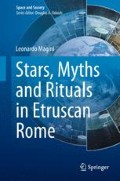Abstract
The Goddess Fortuna—who was imported to Rome by her protégé Servius Tullius – has lunar characteristics.
Access this chapter
Tax calculation will be finalised at checkout
Purchases are for personal use only
Notes
- 1.
Ratri-mani is one of the many ways of referring to the Moon in Sanskrit.
- 2.
Plutarch, de fortuna romamorum, 320 BCE; see no. 1.2.
The geese awakened by Fortuna in Plutarch, de fort. Rom., 325 BCE.
Fortuna, the window and Servius Tullius in Plutarch, de fort. Rom., 322E: δια τινος θυριδος
καταβαινουσαν εις το δωματιον, ο νυν Φενεστελλαν πυλην καλουσιν, and in Ovid, Fasti, 6.577-8: nocte domum parva solita est intrare fenestra; / unde Fenestellae nomina porta tenet.
- 3.
Torelli 1984, p. 126, recalls a passage in Dio Cassius (42.26.4) in which he describes a statue of Fortuna “which […] must see and consider everything that is in front of its eyes and behind too, lest she forget her origins, the place from which she began before she became what she is today,” noting that “Fortuna Respiciens coincides particularly well with the Aphrodite Kallipyge type”.
Author information
Authors and Affiliations
Corresponding author
Rights and permissions
Copyright information
© 2015 Springer International Publishing Switzerland
About this chapter
Cite this chapter
Magini, L. (2015). The Movements of the Moon and Venus and the Language of Myth. In: Stars, Myths and Rituals in Etruscan Rome. Space and Society. Springer, Cham. https://doi.org/10.1007/978-3-319-07266-1_8
Download citation
DOI: https://doi.org/10.1007/978-3-319-07266-1_8
Published:
Publisher Name: Springer, Cham
Print ISBN: 978-3-319-07265-4
Online ISBN: 978-3-319-07266-1
eBook Packages: Physics and AstronomyPhysics and Astronomy (R0)

